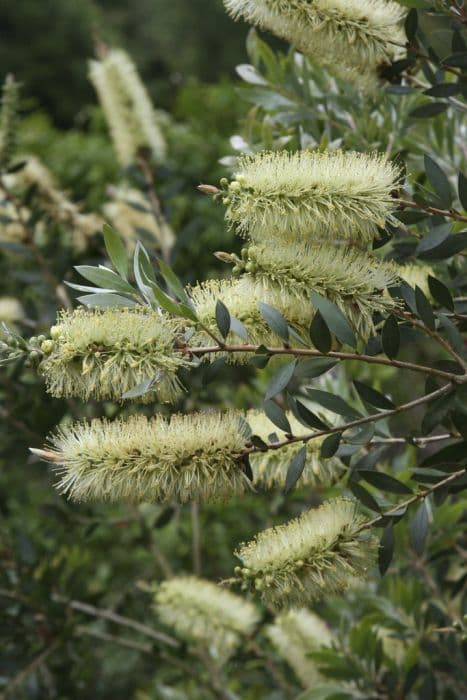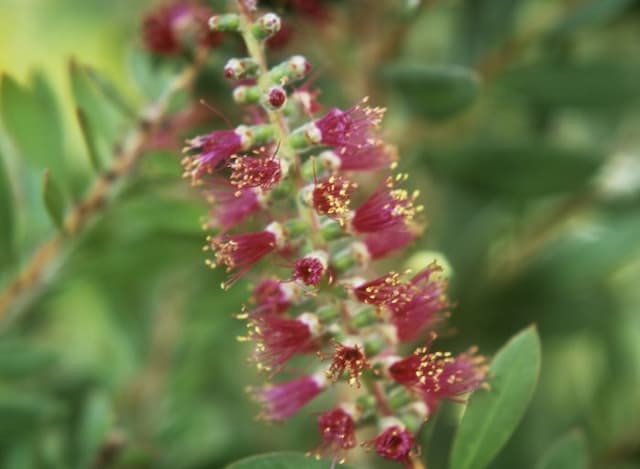Snow Gum Eucalyptus pauciflora subsp. niphophila

ABOUT
The plant commonly known as the Snow Gum typically exhibits a striking appearance, characterized by its smooth, creamy-white bark that often features patches of grey and green. The bark has a tendency to shed in flakes, giving the tree a multicolored, marbled look that stands out in its natural environment. Its leaves are a glossy green, with a sickle shape that gently curves, conjuring a graceful visual effect. During the flowering period, the Snow Gum produces white flowers that cluster in groups, adding a delicate touch of beauty to the already picturesque plant. The overall impression of the Snow Gum is one of both resilience and aesthetic appeal, making it a distinctive member of its genus.
About this plant
 Names
NamesSynonyms
Snow Gum, Snow Eucalypt, White Sallee, Cabbage Gum, Weeping Gum, Ghost Gum
Common names
Eucalyptus pauciflora var. niphophila, Eucalyptus niphophila.
 Toxicity
ToxicityTo humans
Eucalyptus, specifically the Snow Gum, is generally considered to have some toxic properties if ingested by humans. It contains compounds, such as eucalyptol, that can be harmful. Ingesting the leaves can cause symptoms including stomach pain, nausea, vomiting, and diarrhea. In severe cases, it can lead to central nervous system depression and even coma. Children are particularly at risk of eucalyptus poisoning. It is advised to avoid consumption of any part of the plant.
To pets
Eucalyptus is also toxic to pets, including dogs and cats. The Snow Gum contains essential oils and compounds such as eucalyptol, which can be harmful if ingested. Symptoms of poisoning in pets may include drooling, vomiting, diarrhea, depression, weakness, and in severe cases, seizures or collapse. It is important to prevent pets from chewing on the leaves or any part of the plant. If ingestion occurs, it is important to seek immediate veterinary care.
 Characteristics
CharacteristicsLife cycle
Perennials
Foliage type
Evergreen
Color of leaves
Varies
Flower color
White
Height
20 feet (6 meters)
Spread
10 feet (3 meters)
Plant type
Tree
Hardiness zones
7
Native area
Australia
Benefits
 General Benefits
General Benefits- Landscape Aesthetics: Snow Gum offers visual interest with its attractive bark, which peels off in strips to reveal a patchwork of colors.
- Shade Provider: It is capable of providing ample shade in gardens and parks due to its broad canopy.
- Windbreak: Snow Gum can act as a windbreak, offering protection from strong winds for both gardens and buildings.
- Erosion Control: The extensive root system helps stabilize the soil, reducing erosion on slopes and disturbed areas.
- Wildlife Habitat: The tree provides habitat for various bird species, small mammals, and insects that feed on nectar and find refuge in its branches.
- Drought Resistance: Snow Gum is adapted to survive in harsh environments, requiring minimal water once established and providing greenery in arid conditions.
- Frost Tolerance: It has a high tolerance to frost, making it suitable for cold climates where other plants might not survive.
- Revegetation: The species is useful in revegetation projects to recreate native ecosystems and increase biodiversity.
 Medical Properties
Medical Properties- Antimicrobial: Eucalyptus pauciflora subsp. niphophila, commonly known as Snow Gum, has essential oils that are believed to possess antimicrobial properties, potentially inhibiting the growth of certain bacteria, fungi, and viruses.
- Analgesic: The essential oils extracted from Snow Gum may have analgesic effects, which could help to relieve pain when applied topically.
- Anti-inflammatory: The compounds within Snow Gum essential oils might exhibit anti-inflammatory properties, which can help reduce inflammation in tissues.
- Expectorant: Snow Gum is thought to have expectorant qualities, which can aid in the relief of congestion and coughs by helping to expel mucus from the respiratory tract.
- Antiseptic: The oil from the Snow Gum holds antiseptic properties, which may be beneficial for cleaning wounds and preventing the growth of microbes.
 Air-purifying Qualities
Air-purifying QualitiesThis plant is not specifically known for air purifying qualities.
 Other Uses
Other Uses- Snow Gum wood is often used for crafting furniture due to its durability and attractive grain.
- The bark of Snow Gum can be used in papermaking, providing a unique texture and color to handmade papers.
- In landscape design, Snow Gum is planted as a windbreak to protect smaller, less hardy plants.
- The strong, straight trunks of Snow Gum are sometimes used in rural areas for fence posts and other building materials.
- Due to its growth habit and interesting bark, Snow Gum is used as an ornamental tree in parks and gardens.
- Snow Gum leaves can be steeped in water to create a natural dye for textiles, yielding a range of earth-toned colors.
- Wood from the Snow Gum tree is used for fuel; it burns slowly and provides long-lasting heat.
- The tree is also planted on slopes and hillsides to prevent soil erosion and maintain stability in the landscape.
- Dried Snow Gum leaves are sometimes used in potpourri mixes because of their pleasing scent and texture.
- Bees are attracted to Snow Gum flowers, making the trees beneficial for supporting local pollinators and honey production.
Interesting Facts
 Feng Shui
Feng ShuiThe Snow Gum is not used in Feng Shui practice.
 Zodiac Sign Compitability
Zodiac Sign CompitabilityThe Snow Gum is not used in astrology practice.
 Plant Symbolism
Plant Symbolism- Resilience: Also known as Snow Gum, Eucalyptus pauciflora subsp. niphophila is symbolic for resilience due to its ability to thrive in alpine conditions and withstand cold, snowy environments.
- Healing: Snow Gum is often associated with healing properties, as eucalyptus in general is used in medicinal treatments for its antiseptic and soothing qualities.
- Purification: The plant is linked to purification because the eucalyptus oil is commonly used in cleaning products and air purifiers for its fresh and clean scent.
- Protection: Snow Gum can also symbolize protection, tying in with its resilient nature and its traditional use by indigenous Australians to ward off illnesses and evil spirits.
- Regeneration: Given its capacity for regrowth after bushfires, this plant expresses the symbolism of regeneration, reflecting the ability to recover and renew after difficult conditions.
 Water
WaterSnow Gum requires moderate watering during its growing season, roughly every one to two weeks, based on soil dryness. Deep watering is preferred, which encourages the roots to grow downwards, granting the plant stability and drought tolerance. A total of about 2 gallons per watering session is ample to saturate the root zone of a young, medium-sized Snow Gum. Reduce watering frequency during the cooler months to prevent root rot, monitoring the soil moisture before adding water. Mature trees are drought-resistant and may only need supplemental watering during prolonged dry spells.
 Light
LightSnow Gum thrives in full sunlight, with at least six hours of direct sun exposure daily. Well-suited for spacious, open areas without significant shade from buildings or other vegetation, it's important to plant the Snow Gum in a spot where it can receive unobstructed sunlight throughout the day to ensure vigorous growth.
 Temperature
TemperatureSnow Gum is known for its cold hardiness, tolerating temperatures down to around 10 degrees Fahrenheit. Ideal growing temperatures range from 60 to 75 degrees Fahrenheit, but it can survive brief periods of colder winter temperatures. Heat tolerance varies, but it generally withstands temperatures up to around 90 degrees Fahrenheit without stress.
 Pruning
PruningPruning Snow Gum is mainly for removing dead or damaged branches and maintaining a desired shape or size. The best time to prune is late winter or early spring, before new growth begins. It can be pruned as often as needed to remove problematic branches, but extensive pruning should be done sparingly to avoid stress to the tree.
 Cleaning
CleaningAs needed
 Soil
SoilSnow Gum prefers a well-drained soil mix with equal parts of loam, sand, and compost; it thrives with a pH range of 6.0 to 7.5.
 Repotting
RepottingSnow Gum should be repotted every 2 to 3 years to encourage healthy growth and prevent root-bound conditions.
 Humidity & Misting
Humidity & MistingSnow Gum is tolerant of various humidity levels but prefers drier conditions akin to its native Australian alpine habitat.
 Suitable locations
Suitable locationsIndoor
Ensure bright light, cool conditions, and air circulation for indoor Snow Gum.
Outdoor
Plant in well-draining soil, full sun, and protect from extreme cold.
Hardiness zone
7-10 USDA
 Life cycle
Life cycleEucalyptus pauciflora subsp. niphophila, commonly known as Snow Gum, begins its life cycle with seed germination, which occurs in favorable conditions of moisture and temperature. After germination, the seedlings establish themselves and begin to form a root system and the first few leaves. As the sapling grows, it develops a characteristic smooth, mottled bark and an evergreen canopy, adapting well to the alpine and sub-alpine environments. The Snow Gum reaches maturity and starts to flower, producing white flowers that are attractive to pollinators; after pollination, these flowers develop into woody fruit capsules containing numerous seeds. The capsules eventually open to release seeds into the surrounding environment, completing the reproductive cycle. Over time, mature Snow Gums may experience periodic episodes of dieback from which they can resprout, allowing the tree to recover and continue its life cycle into old age.
 Propogation
PropogationPropogation time
Spring-summer
Snow Gum, also known as Eucalyptus pauciflora subsp. niphophila, is commonly propagated by seed. The ideal time for sowing seeds is in the spring after the last frost, when the temperature begins to warm up. To propagate Snow Gum by seed, fill a pot with a well-draining seed starting mix and sprinkle the tiny seeds on the surface, then lightly cover them with a thin layer of soil. Water gently to moisten the soil without disturbing the seeds. Place the pot in a warm, bright location, avoiding direct sunlight which may scorch the delicate seedlings. The seeds usually germinate within a couple of weeks to a few months, depending on the freshness of the seed and growing conditions. Once seedlings are large enough to handle, they can be transplanted into individual pots and eventually into the ground when they have sufficiently matured.








![New Zealand myrtle [Black Pearl]](/_next/image?url=https%3A%2F%2Fplants-admin.emdemapps.com%2Fimages%2Fplants%2F%2Fimages%2F604b53688d37e.png&w=640&q=75)
